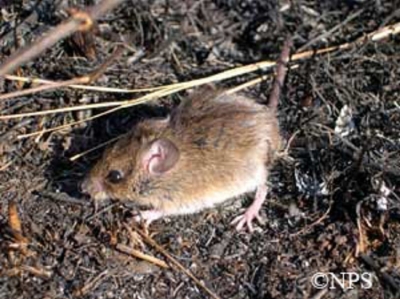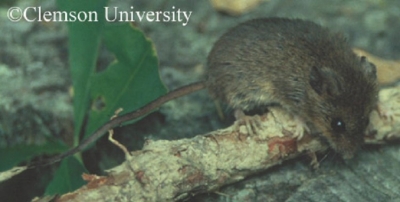Eastern Harvest Mouse, Reithrodontomys humulis
The Eastern Harvest Mouse is a small inhabitant of old or abandoned fields snf are distributed state-wide in Tennessee.
Description: A small mouse with a rich brown fur coat washed with gray, and a dark stripe usually running down the back. The sides are lighter in color and the grayish belly is strongly demarcated by a line on the sides. Ears are all black in color and the feet are grayish-white. The bi-colored tail, which is about equal to the body length, is darker above and lighter below.
Length: 4.3 - 5.0 inches
Tail: 1.8 - 2.4 inches
Ears: 0.3 - 0.4 inches
Weight: 0.25 - 0.38 ounces
Similar Species:
•Golden Mouse is yellowish to golden-brown in color.
•Meadow Jumping Mouse and Woodland Jumping Mouse have very long tails.
•**The Eastern Harvest Mouse can often not be separated from House Mouse and Peromyscus species without detailed analysis of skull and dental formulas, and possibly an expert.
Habitat:
They use a variety of open or brushy habitats, but prefer old fields, abandoned fields, and briar thickets. Tall grasses, such as broom sedge, are usually associated with their old field habitats. Roadside ditches and wet bottomlands are used as well.
Diet:
Primarily eats seeds, fresh plant sprouts, and small insects.
Breeding information:
They breed almost year round, but reproduction peaks in the spring and fall. Gestation lasts 21-22 days resulting in 1-8 (average 3-4) young per litter. Nests, which are made of finely shredded grasses, are globular in shape and placed above ground in tangled vegetation or at the base of grass clumps. Weaning is complete by the 2nd or 3rd week and the young leave the nest by the 4th week.
Status in Tennessee:
The Eastern Harvest Mouse is not a species of conservation concern, but it is uncommon.
Fun Facts:
•Like all harvest mice, the Eastern Harvest Mouse is distinguished by the deep, lengthwise grooves in its upper incisors.
•John James Audubon and his friend John Bachman discovered this species near Charleston, South Carolina in 1841.
Best places to see in Tennessee: Old fields, meadows, and thickets with broom sedge.

